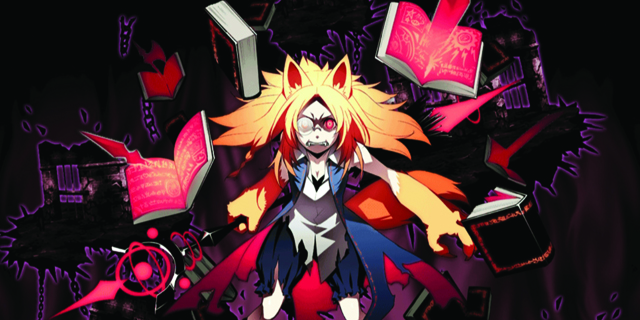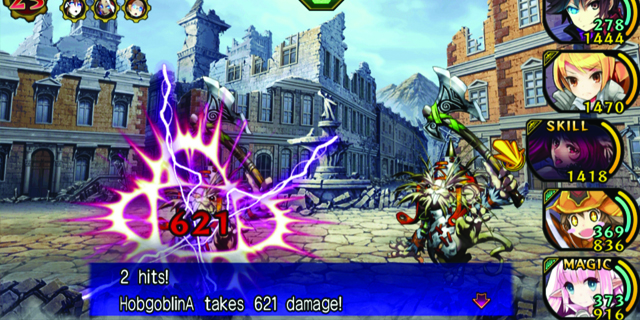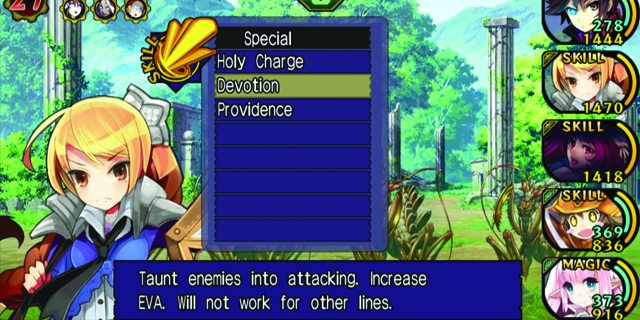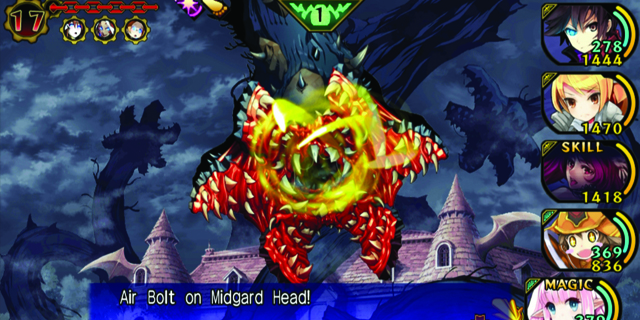
New releases on the Vita may be slowing down lately, but publisher NIS America is doing its best to keep system owners happy. By the end of the summer, the company will have released four separate games on the system in 2014, and Demon Gaze, the second, follows the release of the well-received Danganronpa: Trigger Happy Havoc. How does it stack up with previous NIS releases, as well as other dungeon-crawlers?
You start the game in a dungeon, unsure of how you got there in the first place, only to be encountered by a rather goofy-looking mercenary who warns you of incoming trouble. As the mercenary reaches an untimely end, you encounter the danger mentioned by your now-lifeless friend. This world is infested with demons. You soon meet a woman by the name of Lancelorne, who gives you a weapon. Upon defeating the demon, you learn that you possess a rather unique ability: you’re a Gazer, someone with the ability to control demons. Leaving the dungeon with Lancelorne, you discover you were in the basement of the Dragon Princess Inn, a safe haven amongst these lands riddled with monsters and demons. Fran, the stingy, but fair manager of the inn tasks you with capturing all the demons wreaking havoc in the area.

In between your main goal, several mundane tasks are thrown your way either by story progression or optional help via the bulletin board, as well as learning and fostering relationships with the game’s colorful cast. The rivalry between Lezerem, the Elven item shop owner, and Cassel, the weapon shop proprietor, is something constantly highlighted in the game, as well as sleepy mortician of the inn Prometh’s inability to wear clothing.
The character visuals, at least, are highly detailed, and the obvious highlight of this game. From the NPCs to the pre-loaded avatars you can choose for yourself and your party, each are visually stunning and show a lot of thought and effort. Unfortunately, highlighting one thing usually means something else suffers. In this case, it’s the dungeon design. The 3D environments of the dungeons seem to have become an afterthought, despite being one of the areas in the game you’ll be around the most.
Dungeons in the game have an Etrian Odyssey-reminiscent feel, making it difficult right off the bat, but rewarding down the line when everything starts falling into place. Unlike Etrian Odyssey, however, you can’t just create an entire team off the bat and start exploring. While the first character is added to your party for free, adding more could cost you up to 5,000 gold each. Creating the character is one fee, and giving them a room in the inn is another fee and necessary if you want them in your party. In addition to the odd character fees, you pay rent to Fran upon returning to the inn. The amount continually goes up during each encounter. It’s an expensive process, but worth it when you finally have your party set to your liking.

While Demon Gaze is largely a typical dungeon-crawler, the game features some unique aspects. Through Gazer Memos, players are allowed to write and leave notes for other players to read to either help them on their journey, or distract them and wonder why the system was put in place to begin with. With luck, you’ll read one that tells you about nearby loot hidden in walls. Other times, you’ll read one with players professing their love for certain in-game NPCs. More often, it’s something like the latter.
Demon Circles are also a huge aspect of the game’s dungeon crawling experience, since they serve four purposes: on-map save points when the demons inside are defeated, dungeon progression since circles need to be beaten once to reveal the location of the dungeon’s boss, a way to manage the Demon Keys you earn throughout the game and a chance to earn various items without heading to the weapon shop.
You can drop up to three gems inside the circle. It’s a great way, and a rather addicting one, to earn equipment for characters, since you always know what you’re going to get out of it. If you need a new helmet or a sword for your Gazer, just drop those types of gems in the circle and see what you can get. If you’re out of circles to drop gems in, they reset every time you leave the dungeon, so it gives you more incentive to return to earlier locations in the game. Artifacts can also be earned in dungeons and circles to help your party learn various abilities out of their class, and create some potentially broken combinations.

Combat uses a simple and very traditional turn-based scheme, but summoning possessed demons and using them for battle serves as a change of pace. Unlike teammates, you can’t control the actions of demons mid-battle. They act on their own accord and have their own HP bars as well. They also have a gauge that helps them perform actions, but also serves as a timer. When the demon gauge hits zero, the demon goes into a rage and will powerfully attack friend and foe indiscriminately. Demons can also prevent damage from various floor hazards, as well as reveal the location of hidden doors needed to advance around the map.
Demon Gaze will definitely start out rough, but once you get past the walls in the beginning of the game, you’ll find a challenging, rewarding dungeon-crawler for core players. The limitless party combinations and builds definitely make it compelling to work toward the best loadout for your party. If you like Etrian Odyssey-style games and own a Vita, this one is definitely worth checking out.
Pros: Rewarding gameplay, compelling NPCs, interesting loot system
Cons: Steep learning curve, narrative pacing issues



















